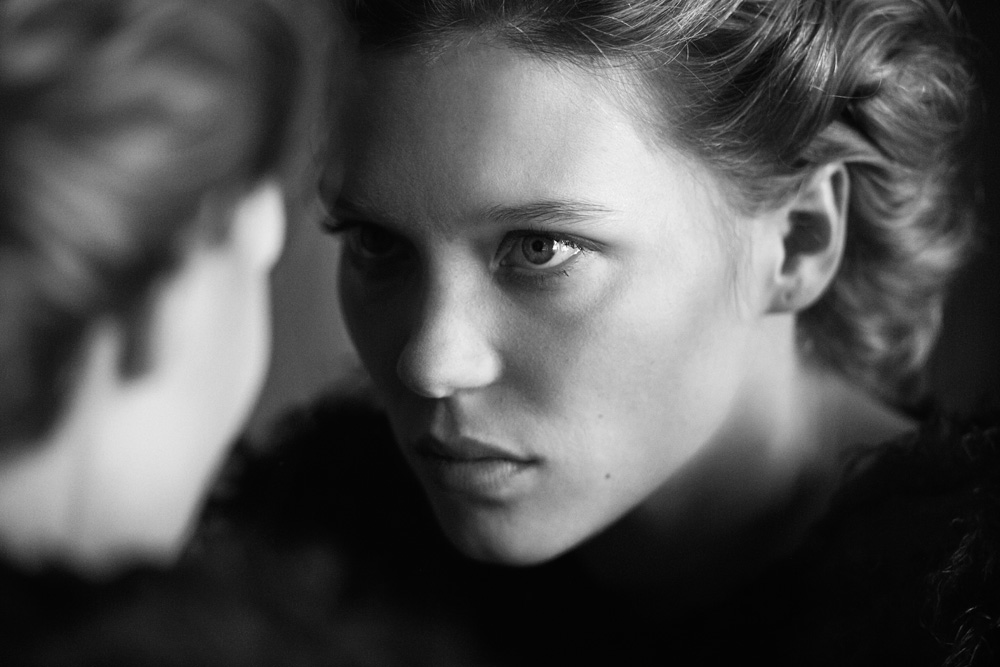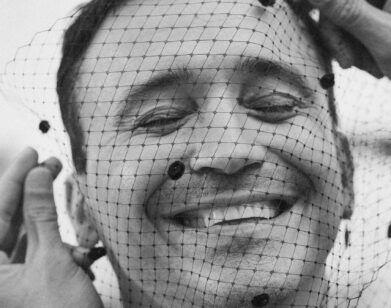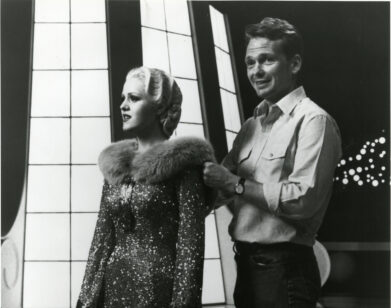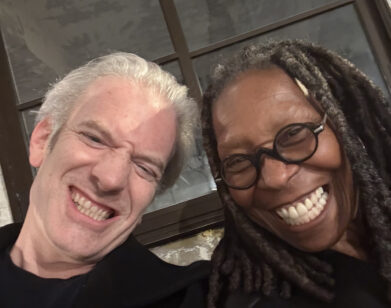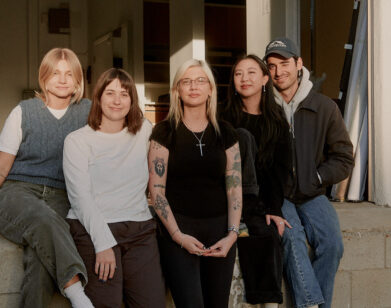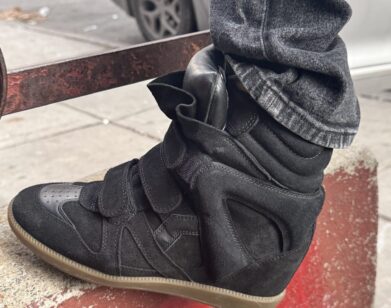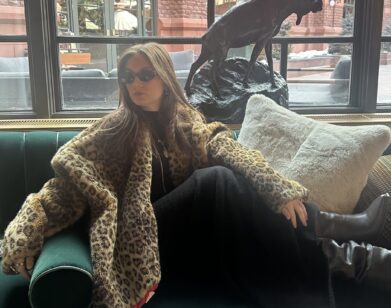Léa Seydoux by Peter Lindbergh
The photographer, even in fashion and portraiture, has to have a standpoint. It’s important to know what you stand for, no? Peter Lindbergh
Peter Lindbergh is a German photographer born in 1944 in what is now Poland. He lives in Paris, New York, and the Provencal town of many a van Gogh sunflower, Arles. And perhaps it is this cosmopolitan cocktail or the wanderings of his youth that give such sumptuous depth to his classical portraits, often in black-and-white, of the most beautiful women of the last half-century. So iconic are these images that it’s difficult to even hear the word supermodel without picturing Christy, Linda, Cindy, Naomi, Stephanie, and Helena, prancing on a beach arm in arm or huddled in a New York street in Lindbergh’s often imitated minimalist pictures of the era.
As Lindbergh explains to actress Léa Seydoux, whom he photographed with signature power and intimacy in a Parisian hôtel particulier, this legacy allows him to explore even more deeply the personal and political dimensions of his work. He wants to both tell a story and tell it like it is.
LÉA SEYDOUX: So, Peter, it’s my first interview. I’m very excited. [laughs] I want to start from the beginning, when you were a kid. What were your first obsessions?
PETER LINDBERGH My first obsession was actually sports. I was a very good handball goalkeeper. With special permission, I played in the premier league in Germany before I was even old enough. When I became 18 years old, I knew I definitely didn’t want to go to the German military service, so I went to Switzerland and stopped my sports career. Eight months later, I went to Berlin for a year and a half, and that’s where I learned about culture and art and everything. Before that, I lived in total absence of culture. I come from a house where there was nothing like reading or art—the opposite of yours.
SEYDOUX: And when did your fascination begin with Vincent van Gogh?
LINDBERGH: When I went to the Academy [of Arts], in Berlin, they wanted you to paint and draw as realistically as possible, saying that was the basis for an artist. I was flabbergasted and said to myself, “What? This is from the past.” I thought, “No, this is not my place. I want to go to Arles, because van Gogh lived there, and I want to see the light and everything else he used as inspiration for his revolutionary paintings.” I was inspired by his powerful interpretation of nature. So I hitchhiked to Arles and stayed there for eight months. That’s more exciting than drawing realist pictures for two years, no?
SEYDOUX: Did you discover photography in art school?
LINDBERGH: No, not at all. After the eight months in Arles, I hitchhiked through Spain, Morocco, and the south of France for another year and a half. When I came back, I stopped in Düsseldorf, and then went to art school in Krefeld, where I studied for three and a half years. I did something called “free painting,” but never touched photography. It’s a long story why I stopped being a painter, because I was quite successful in the beginning. I had an exhibition at Galerie Denise René, Hans Mayer in Krefeld, one of the great avant-garde galleries in Germany, in September 1969, while I was still in art school, which was rather a miracle. When I finished art school, I went to live in Düsseldorf and something surprising took place. I read an article by Klaus Honnef about conceptual art and went to see Joseph Kosuth’s piece One and Three Chairs [1965]. The work of Kosuth, Lawrence Weiner, Douglas Huebler, and others turned all my knowledge about art upside down. I could not accept what I did anymore. I wanted to do something different, a project that touched people intellectually. But that didn’t really feel like me. So I decided to stop working as an artist, to find out where I really wanted to go. For six or seven months, I didn’t do anything, which was very unusual for me. And then, accidentally, a friend of mine knew of a photographer friend who was looking for an assistant. So I went to assist [Hans Lux]. Nearly two years later, about 1973, I started my own studio in Düsseldorf. That was the switch from art to photography. Now people ask whether photography is art, but I think the question is of absolutely no interest.
SEYDOUX: Is there a link between your painting and pictures?
LINDBERGH: Everything is linked. It’s about expression or about taking a position. The photographer, even in fashion and portraiture, has to have a standpoint. It’s important to know what you stand for, no? [laughs] Most people just take pictures but they stand for nothing. They follow trends and don’t know why.
SEYDOUX: How did you come to fashion?
LINDBERGH: When I started, art photography, like that of Andreas Gursky, and Thomas Struth, didn’t exist. There were artists doing photography, like Michael Heizer and [Walter] De Maria, but they were just documenting their work. So fashion photography was the creative path for a photographer. Comme des Garçons came to France in the ’80s, and getting commissioned by them was as artistic as it could get. I still think Rei Kawakubo is more an artist than a designer, no? I thought fashion was just the pretext to do images with lots of freedom and get them published in magazines. You could express your point of view, make statements about women and about what you believe in.
SEYDOUX: What was the industry like then?
LINDBERGH: In the end of the ’70s, everything was starting. Karl Lagerfeld was in Paris. I was sent to Milan to photograph Giorgio Armani and Gianni Versace, and nobody knew them yet.
SEYDOUX: What was your first shoot that really broke through?
LINDBERGH: While I was in Germany, I photographed primarily for advertising. My images were apparently different. At one point somebody from the editorial world saw my work and said, “I want you to work for Stern magazine.” It was the big German magazine at the time—not fashion, but twice a year it had a 14-page spread reporting on the shows in Paris, which was usually shot by Helmut Newton, Hans Feurer, or Guy Bourdin. I was really surprised when they called me. I didn’t have much culture at this time—I didn’t take inspiration from other photographers—which in a way helped to find my own images. The first fashion series I did for them was ridiculously successful. And from there, I got calls from Paris, from magazines like Marie Claire, saying, “We’ll give you a contract. Come work for us every month.”
SEYDOUX: Who are your favorite subjects? Is there a type of woman you find exciting to photograph again and again?
LINDBERGH: When I start thinking about a story, I don’t start by thinking about the fashion, but about who I want to photograph and what the story should be about. In the story I just did, I wanted to photograph a woman who left her house and her family and took a ferry boat from England to the French coast, where she has never been, to come to terms with herself. To work like this is a very beautiful process.
SEYDOUX: Is there anyone you wish to photograph?
LINDBERGH: God, yes. I would love to photograph Angelina Jolie. A friend of mine is working with her on her next film and told me what I was already suspecting, that she is extremely interesting. I have never seen a picture of her that conveys all of her complexity. That would be a fabulous challenge, to find that in a photograph.
SEYDOUX: What are your favorite photographs that you’ve taken?
LINDBERGH: In 1990 I did a story with Helena Christensen about a woman who lives in a trailer in the middle of the desert and finds a little crushed UFO with a martian who has survived the crash. She takes him home, and they fall in love. Later he has to meet with his fellow martians who have arrived to rescue him. It’s a sad ending. [laughs] This was my first truly narrative story and apparently the first narrative story in fashion photography.
SEYDOUX: Who are your inspirations, the photographers you love?
LINDBERGH: I grew up with [Richard] Avedon, Irving Penn, and Helmut Newton—the masters of the previous generation. Each had a distinctive and totally personal style. But I also love and admire photographers like Don McCullin, a British war reporter, who worked for The Sunday Times and said of himself, “I want to be the toughest photographer in the world.” And Sebastião Salgado, the great Brazilian master of social documentary. I admire Diane Arbus for her intense honesty and Bruce Weber for his own distinctive style.
SEYDOUX: Can you tell me a little about your meditation practice?
LINDBERGH: In the beginning of my twenties, I started transcendental meditation. For years I did nothing else. Every holiday I went to courses. Meditation is a real simple instrument. You don’t need a long beard or a sari. It’s meant to bring you to yourself. It’s as easy as that. And that’s what it’s all about, being alone with yourself every day, for 20 minutes in the morning and 20 minutes in the evening.
SEYDOUX: What do you do?
LINDBERGH: I have a mantra, which I start thinking, or rather, feeling. And by feeling your mantra inside of you, you slowly separate from everything around you. After a few minutes, you are just with yourself, without any thoughts. Just you. I’ve been doing it for over 45 years and, because of it, have a very different relationship with myself. You become another person, with a very different sensibility. That sounds very dramatic, but it’s a very simple thing.
SEYDOUX: I have a last question, Peter. Why do you photograph?
LINDBERGH: Photography gives you the opportunity to use your sensibility and everything you are to say something about and be part of the world around you. In this way, you might discover who you are, and with a little luck, you might discover something much larger than yourself. No?
FRENCH ACTRESS LÉA SEYDOUX’S UPCOMING FILMS INCLUDE SAINT LAURENT AND THE LOBSTER.
For more from the Photographers’ Portfolio, click here.

